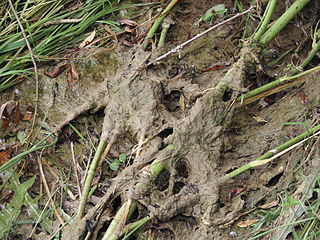
Didymosphenia geminata, commonly known as didymo or rock snot, is a species of diatom that produces nuisance growths in freshwater rivers and streams with consistently cold water temperatures and low nutrient levels. It is native to the northern hemisphere, and considered an invasive species in Australia, Argentina, New Zealand, and Chile. Even within its native range, it has taken on invasive characteristics since the 1980s. It is not considered a significant human health risk, but it can affect stream habitats and sources of food for fish and make recreational activities unpleasant. This microscopic alga can be spread in a single drop of water.

Teldenia is a genus of moths belonging to the subfamily Drepaninae.
Mattesia is a genus of parasitic alveolates of the phylum Apicomplexa. Species in this genus infect insects.

Teldenia specca is a moth in the family Drepanidae. It was described by Wilkinson in 1967. It is found in the north-eastern Himalayas and from western China to Borneo, Sumatra, Palawan, Buru and New Guinea.
Teldenia psara is a moth in the family Drepanidae. It was described by Wilkinson in 1967. It is found on Seram.
Teldenia melanosticta is a moth in the family Drepanidae. It was described by Wilkinson in 1967. It is found on Fergusson Island and in New Guinea.
Teldenia desma is a moth in the family Drepanidae. It was described by Wilkinson in 1967. It is found in New Guinea.
Teldenia apata is a moth in the family Drepanidae. It was described by Wilkinson in 1967. It is found in New Ireland, New Britain, Rook Island and New Hanover.
Teldenia cathara is a moth in the family Drepanidae. It was described by Wilkinson in 1967. It is found on Rook Island and New Britain.
Teldenia aurilinea is a moth in the family Drepanidae. It was described by Warren in 1922. It is found in New Guinea, where it is only known from the Arfak Mountains.
Teldenia ruficosta is a moth in the family Drepanidae. It was described by Warren in 1922. It is found in West Papua.
Teldenia obsoleta is a moth in the family Drepanidae. It was described by Warren in 1896. It is found in Burma, Indonesia and the Philippines.
Teldenia illunata is a moth in the family Drepanidae. It was described by Warren in 1907. It is found in New Guinea.
Teldenia moniliata is a moth in the family Drepanidae. It was described by Warren in 1902. It is found on the Solomon Islands.
Teldenia unistrigata is a species of moth in the family Drepanidae. It was described by Warren in 1896. It is found on Peninsular Malaysia, Borneo, Sumatra, the Philippines, Sulawesi and New Guinea.
Teldenia pura is a moth in the family Drepanidae. It was described by Warren in 1899. It is found in New Guinea and on Goodenough Island, Fergusson Island and Admiralty Island.
Teldenia niveata is a moth in the family Drepanidae. It was described by Pagenstecher in 1896. It is found on Sulawesi.
Teldenia alba is a moth in the family Drepanidae. It was described by Frederic Moore in 1882. It is found in Sri Lanka.
Teldenia latilinea is a moth in the family Drepanidae. It was described by Watson in 1961. It is found on Sulawesi.
Teldenia subpura is a moth in the family Drepanidae. It was described by Rothschild in 1915. It is found in West Papua and on Obi Island and Sulawesi.

